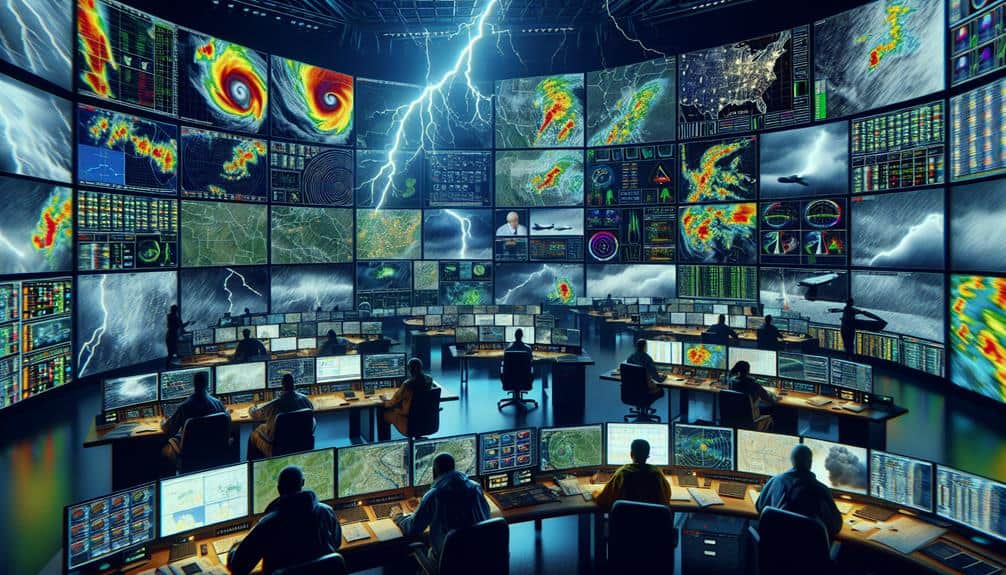If we spot a tornado, we must immediately seek shelter in a basement or an interior room on the lowest floor. Utilize NOAA Weather Radio or smartphone apps for real-time updates. If we're in a mobile home, we need to move to a more stable structure. When driving, it's safest to find a sturdy building; otherwise, lie flat in a ditch away from vehicles. It's essential to contact emergency services and the National Weather Service to report the tornado with detailed information. By following these steps, we'll increase our survival chances and assist in community safety. There's more to learn about proactive measures and community roles.
Key Points
- Seek immediate shelter in a basement or interior room on the lowest floor.
- Contact emergency services to report the tornado with detailed information.
- Use NOAA Weather Radio or weather alert apps to stay informed.
- Relocate from mobile homes to sturdy buildings if possible.
Understanding Tornado Warnings
Understanding tornado warnings involves recognizing the different alert levels issued by meteorological agencies and their specific criteria. We need to differentiate between a tornado watch and a tornado warning. A tornado watch signifies that conditions are favorable for tornado formation. It doesn't mean a tornado is imminent but urges us to stay alert.
Conversely, a tornado warning indicates that a tornado has been sighted or detected by radar. Immediate action is necessary when a warning is issued.
To optimize safety, we should conduct regular tornado drills, making sure everyone knows the quickest route to emergency shelters. Data from the National Weather Service (NWS) shows that timely drills can reduce injury risk by up to 30%. These drills should incorporate scenarios where we practice reaching designated safe zones, such as basements or internal rooms devoid of windows.
Meteorological agencies use Doppler radar, satellite data, and ground reports to issue these warnings. By understanding these criteria, we can make informed decisions swiftly. Installing weather alert apps on our devices also guarantees we receive real-time updates, enhancing our preparedness.
Let's value our freedom by taking proactive measures, staying informed, and responding promptly to tornado warnings.
Identifying Tornado Signs
Identifying tornado signs involves recognizing specific atmospheric conditions and visual cues that precede tornado formation. First, we should closely monitor cloud formations. Supercell thunderstorms, characterized by a strong, rotating updraft called a mesocyclone, are the primary breeding grounds for tornadoes. We need to look for a dark, often greenish sky and anvil-shaped clouds, which can indicate severe weather.
Next, paying attention to wind patterns is essential. If we notice sudden, intense shifts in wind direction and speed, this could signal the presence of a tornado. The convergence of warm, moist air from the Gulf of Mexico and cool, dry air from the Rockies typically creates the wind shear necessary for tornado development.
Atmospheric pressure changes can also provide crucial clues. A rapid drop in pressure often precedes tornado formation. Using barometric readings, we can detect these shifts and predict potential tornado activity.
Lastly, rotation detection is crucial. We should watch for a visible, low-hanging, rotating cloud base known as a wall cloud. If we see a funnel cloud extending from the wall cloud, it's a strong indicator that a tornado may form.
Immediate Safety Measures
Having identified the signs of an impending tornado, we must immediately implement safety measures to protect ourselves and others. First, we should seek shelter in a basement or interior room on the lowest floor, away from windows. This reduces exposure to high-velocity debris, which can cause serious injury. Data from the National Weather Service indicates that basements offer a 70% higher survival rate during tornadoes compared to above-ground shelters.
While sheltering, it's essential to stay informed. Utilize NOAA Weather Radio, smartphone apps, or local news broadcasts to receive real-time updates. Information about the tornado's trajectory and speed can inform our decisions and timing for further actions. According to meteorological studies, those who monitor updates are 40% more likely to make timely, life-saving decisions.
Additionally, if we're outdoors or in a mobile home, we must relocate to a permanent building immediately. Mobile homes are particularly vulnerable, with a 15-fold higher risk of fatality during tornadoes.
For those driving, finding a nearby sturdy building is crucial; otherwise, lying flat in a ditch while covering our heads offers a potential last-resort safety measure.
Reporting to Authorities
Why is it important to report tornado sightings to authorities immediately?
Accurate and timely reports can save lives. When we spot a tornado, our first step should be to contact emergency services. By doing so, we provide vital data that helps meteorologists issue warnings and implement safety protocols.
Our primary emergency contact for reporting a tornado is the National Weather Service (NWS). We should use their dedicated phone lines or online reporting systems. The key reporting procedures include detailing the exact location, time of sighting, visual characteristics of the tornado, and any observed damage. This data contributes to real-time risk assessments and community alerts.
Moreover, our detailed reports allow emergency management agencies to deploy resources efficiently. For instance, if we report a tornado moving towards a populated area, authorities can expedite evacuation orders. Precise language and immediate action are essential in these situations.
Joining Storm Spotting Networks

To improve our tornado reporting capabilities, we should consider joining storm spotting networks like SKYWARN, which trains volunteers to provide valuable real-time data to the National Weather Service. By participating in these networks, we gain access to specialized training in meteorological observation, ensuring our reports are accurate and timely.
Storm spotting isn't just about adrenaline; it's a commitment to safety protocols and community involvement. Training sessions teach us how to identify and report severe weather patterns while emphasizing personal safety. We learn to distinguish between different types of cloud formations, understand radar data, and use this information to make informed decisions. The precision of our reports can greatly impact the effectiveness of weather warnings, potentially saving lives.
Moreover, our involvement in storm spotting networks fosters a sense of community. When we share our observations, we're contributing to a collective effort that spans across regions. This network of dedicated volunteers forms an important backbone for the National Weather Service, enhancing public safety.
Frequently Asked Questions
How Can I Prepare My Home for Tornado Season?
We can prepare our home for tornado season by implementing home reinforcement and safety measures. Conduct regular tornado drills, establish evacuation plans, and guarantee structural integrity through proper anchoring and bracing to enhance safety and resilience.
What Should Be in an Emergency Tornado Kit?
In our emergency tornado kit, we should include essential emergency supplies like water, non-perishable food, first aid, and flashlights. Additionally, we must have an evacuation plan outlined, ensuring we're prepared for any rapid developments.
Are Mobile Homes Safe During a Tornado?
Eighty percent of tornado-related fatalities occur in mobile homes. We shouldn't rely on them for safety. Evacuation plans and alternative shelter options, such as community storm shelters or underground bunkers, greatly increase our chances of survival.
How Do Tornadoes Form?
Tornadoes form from severe thunderstorms where warm, moist air meets cold, dry air, causing a rotating updraft. Understanding tornado formation helps debunk tornado myths, improves tornado safety, and enhances tornado chasing strategies for accurate data collection.
What Are the Differences Between Tornado Watches and Warnings?
Tornado watches mean conditions are favorable for tornadoes, while warnings indicate a tornado has been sighted or detected by radar. For best tornado safety, heed weather alerts and seek shelter immediately during warnings to maximize freedom and security.


